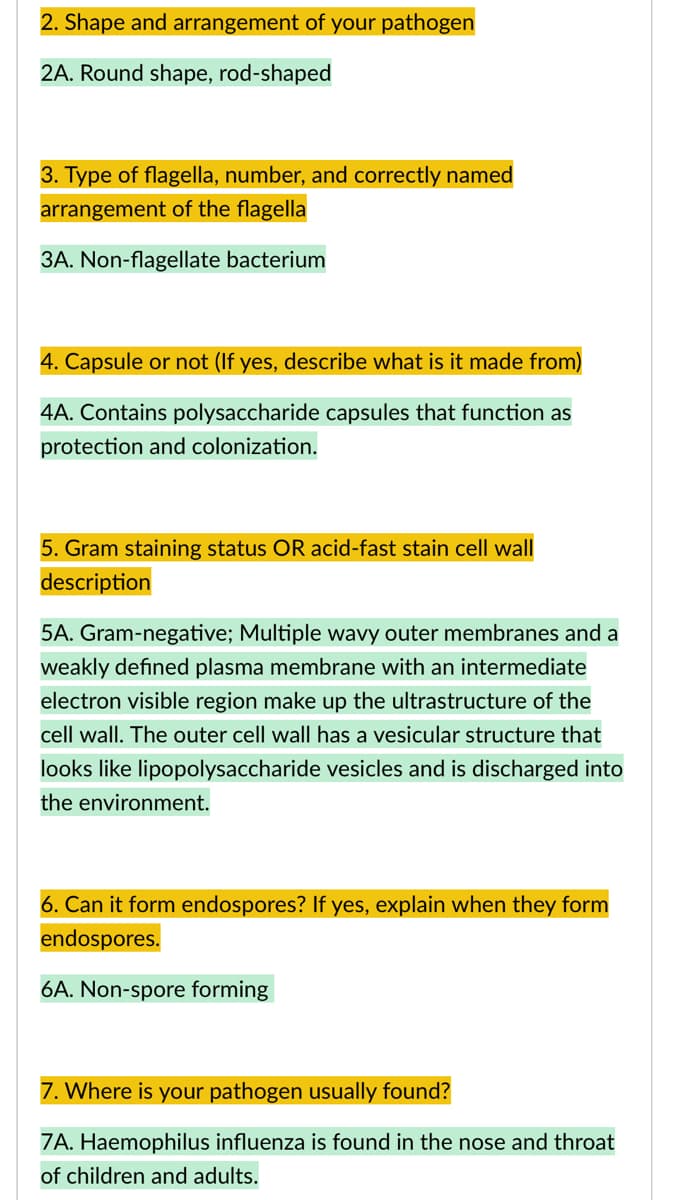Mycobacterium tuberculosis compare how your pathogens (Mycobacterium tuberculosis ) may be similar and different, at least one for each with Haemophilus influenzae ?
Mycobacterium tuberculosis compare how your pathogens (Mycobacterium tuberculosis ) may be similar and different, at least one for each with Haemophilus influenzae ?
Biology 2e
2nd Edition
ISBN:9781947172517
Author:Matthew Douglas, Jung Choi, Mary Ann Clark
Publisher:Matthew Douglas, Jung Choi, Mary Ann Clark
Chapter22: Prokaryotes: Bacteria And Archaea
Section: Chapter Questions
Problem 13RQ: Prokaryotes stain as Gram-positive or Gramnegative because of differences in the cell wall cytoplasm...
Related questions
Question
Mycobacterium tuberculosis
compare how your pathogens (Mycobacterium tuberculosis ) may be similar and different, at least one for each with Haemophilus influenzae
?

Transcribed Image Text:2. Shape and arrangement of your pathogen
2A. Round shape, rod-shaped
3. Type of flagella, number, and correctly named
arrangement of the flagella
3A. Non-flagellate bacterium
4. Capsule or not (If yes, describe what is it made from)
4A. Contains polysaccharide capsules that function as
protection and colonization.
5. Gram staining status OR acid-fast stain cell wall
description
5A. Gram-negative; Multiple wavy outer membranes and a
weakly defined plasma membrane with an intermediate
electron visible region make up the ultrastructure of the
cell wall. The outer cell wall has a vesicular structure that
looks like lipopolysaccharide vesicles and is discharged into
the environment.
6. Can it form endospores? If yes, explain when they form
endospores.
6A. Non-spore forming
7. Where is your pathogen usually found?
7A. Haemophilus influenza is found in the nose and throat
of children and adults.
Expert Solution
This question has been solved!
Explore an expertly crafted, step-by-step solution for a thorough understanding of key concepts.
Step by step
Solved in 2 steps

Knowledge Booster
Learn more about
Need a deep-dive on the concept behind this application? Look no further. Learn more about this topic, biology and related others by exploring similar questions and additional content below.Recommended textbooks for you

Biology 2e
Biology
ISBN:
9781947172517
Author:
Matthew Douglas, Jung Choi, Mary Ann Clark
Publisher:
OpenStax


Biology 2e
Biology
ISBN:
9781947172517
Author:
Matthew Douglas, Jung Choi, Mary Ann Clark
Publisher:
OpenStax
